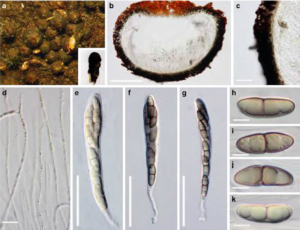Byssosphaeria rhodomphala (Berk.) Cooke, Grevillea 15(no. 75): 81 (1887)
Facesoffungi number: FoF00942; Fig. 1
Saprobic on dead stems of Senecio spp. Sexual morph: Ascomata 360 – 500 (−600) μm high × 300 –500 μm diam. (x̄ = 450 × 470 μm, n = 10), scattered or in small groups, superficial with basal subiculum anchoring them to the substrate, globose, subglobose to turbinate, apapillate, with porelike ostiole, ostiolar region flat, often orange or greenish. Peridium 20 – 55 μm wide, comprising two cell types, outer layer composed of brown, thick – walled cells of textura epidermoidea, inner layer composed of hyaline to pale brown cells of textura angularis. Hamathecium of dense, 0.5 – 1.5 μm broad, long trabeculate pseudoparaphyses, embedded in mucilage, anastomosing between and above the asci. Asci 90 – 120 × 10 – 14 μm (x̄ = 100×12 μm, n=20), 8-spored, bitunicate, fissitunicate, cylindric-clavate, pedicel 15 – 20 (−53) μm long, immature asci usually with a longer and furcate pedicel, apically rounded with an ocular chamber. Ascospores 18 – 23 × 5.5 – 8 μm (x̄ = 20 × 6 μm, n = 40), overlapping biseriate above and uniseriate below, pale brown, fusoid to ellipsoidal with rounded ends, 1 – septate, with hyaline, smooth – walled. Asexual morph: Undetermined.
Material examined – THAILAND, Chiang Rai Province, Bandu, on dead stem, 12 January 2012, H.A. Ariyawansa (MFLU 15-1501, reference specimen designate here).

Fig. 1 Byssosphaeria rhodomphala (reference specimen) a Habitat of the taxon on host substrate b Vertical section through ascoma. Note the reddish region around the ostiole c Close up of the peridium d Pseudoparaphyses e, f Asci h – k Ascospores. Scale bars: b = 200 μm, c = 50 μm, d = 10 μm, e – f = 10 μm, h – k = 20 μm.
